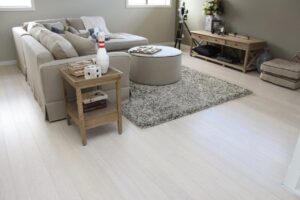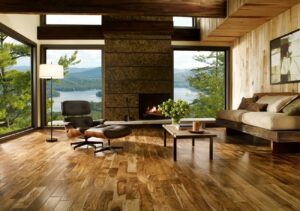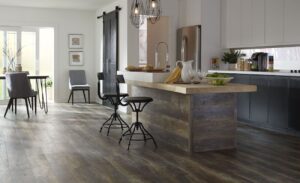Understanding carbonized bamboo flooring is crucially a must. It is due to the fact that people frequently misunderstand though this flooring type has been widely used and become one of the popular flooring type on the globe.
If you associate the word “Carbon” (from the word “carbonized”) with the hard bamboo flooring while the bamboo flooring also show its high rating in Janka hardness scale, carbonized bamboo flooring doesn’t have anything to do with it.
Therefore, we write this article to invite you to know more about the carbonized bamboo including the definition, what carbonizing does to bamboo flooring, the purpose of carbonizing bamboo, steamed feature, carbonizing impact on bamboo materials and the final words about Understanding carbonized bamboo flooring.
So let’s take your time to read all of the review below.
The Definition of Carbonizing
Understanding the definition is the prior thing that everyone should do to go out of the misunderstanding. In fact, Carbonizing bamboo flooring is very much popular.
Now if you are visiting a home improvement stores and look at the darker colored bamboo flooring that looks like stained hardwood, that is the carbonizing bamboo.
Thus, carbonizing bamboo is the process of making the bamboo or lighter to resemble the hardwood-look.
In the other world, the bamboo is processed in such a way to get the darker or lighter color so that it can mimic the look or the hardwood, letting the people misunderstand between the bamboo and hardwood.
Due to its resemblance over hardwood, people might think that it is a hardwood. To differentiate it from the hardwood flooring type, carbonizing bamboo flooring can result a darker shade than the hardwood. This is the thing that you must recognize.
What Carbonizing Does to Bamboo Flooring
We have stated that carbonizing bamboo flooring is dealing with the way the bamboo is processed to mimic the hardwood look. True to its originality, carbon is commonly associated with the hardness and longevity.
It is one of the oldest element existing on Earth. In this high-technological era, carbon is used to add special strong creation to form the highly durable products, one of which is flooring product.
Note, carbonizing bamboo doesn’t mean making the bamboo hard. Instead, carbonizing is addressed to give the bamboo a darker or lighter color, deep and rich color shade. This way, it similarly copy the process of making the wood stained.
The Purpose of Carbonizing Bamboo
Understanding carbonized bamboo flooring will include the reason why it is done and to what extent it will work on the carbonizing process.
Considering that bamboo is natural and coming with the beautiful light color which is much the same with the straw, many people think that bamboo is naturally giving green feel and look without knowing that its color fits their home.
Thus, they frequently misunderstand the carbonizing bamboo from the hardwood.
Thus, carbonizing is carried out to make the bamboo flooring a bit different from wood. Carbonizing is aimed to change the bamboo color either lightening or darkening.
In the end, the final result will show you the bamboo flooring with a hardwood-look yet the bamboo’s characteristics still exist.
Steamed Feature of Carbonizing Bamboo
Staining the hardwood is different from carbonizing bamboo. Staining the hardwood means you are introducing pigment to the wood’s cellular, the porous structure.
This process may lightens the flooring products but pay attention to the foot traffic and direct UV rays that can change the flooring’s color.
On the other hand, carbonizing bamboo is an internal process which is more about changing the material’s color. No pigments are added. Carbonizing involve the method of heat-intensive process including steaming or boiling. This will work better on bamboo materials.
In shirt, carbonization involves the heating system in changing the color of the bamboo. The less heat, the lighter the color is. On the other hand, the more heat, the darker the color will be. As simple as that.
To simply and easily understand the carbonization, let’s refer to the analogy of caramelization. The process of both carbonization and caramelization is similar. In caramelization, the heat causes the sugar to turn brown.
In the other words, the heat application changes the sugar’s color into brown. The less heat, the lighter the color. The more heat, the darker the color. In sugar, the more heat applied makes the sugar turns to black. It becomes black sugar.
Read Also: What is Strand Woven Bamboo Flooring and Purchase It For A Higher Durability
Carbonizing Impact on Bamboo Materials
Now understanding carbonized bamboo flooring also requires you to know the impact of carbonizing on bamboo materials. Because of being carbonized, the bamboo turns to be 1/3 softer than the original bamboo materials.
This way, the carbonization weaken the bamboo materials, meaning that they will be less durable as a flooring material. Additionally, the bamboo flooring will also dimensionally less stable.
To work well with this low durability, aluminum oxide finish is much recommended to use to coat the surface of the bamboo flooring. In the end, the carbonized bamboo flooring can stay normally as a flooring.
Is The Carbonized Bamboo Different From The Other Types Of Bamboo?
Knowing the fact there is so called a carbonized bamboo flooring, a big question may spring up on your mind. Is the carbonized bamboo different from the other types of bamboo or other floorings? The answer is definitely yes.
The same color may be achieved by all types of bamboo floors or wood floors through staining and carbonizing, however, there are some differences though they look the same.
Stained wood changes its color only on the surface while the carbonized bamboo changes its color on the whole planks.
Due to this fact, the carbonized bamboo flooring can be refinished in the same rich color. In addition, the bamboo colors resulted from the carbonization can last proportionally.
Though the carbonization makes the bamboo materials softer, the surface treatments are applied to enable the floors to stand out as the other types of bamboo flooring.
Is Carbonized Bamboo Floors As Durable As Other Flooring Types?
The second question might come asking you overtime is whether or not the carbonized bamboo floors as durable as other flooring types. Well, understanding carbonized bamboo flooring must also consider the durability or the product, right?
Based on Janka hardness test result, the strand-woven bamboo flooring is one of the most durable choices available on the market. In this case, the carbonized bamboo is just one of them, too.
Along with the trustable construction, the carbonized bamboo floor is finally designed with the easy maintenance, versatility and beauty, making it nicely fits the luxury apartments flooring as well as other rental properties.
In fact, the way the bamboo floors are manufactured leads to the toughness and long lasting durability. This one of the major reasons why the carbonized bamboo is harder many times than the traditional hardwood.
Do you know another great fact of carbonized bamboo floors? Truly, they are added with the patented AccuSeal Ultra Finish System offering the lifetime warranty and hassle-free maintenance.
Furthermore, they comes with the manufacturing standards as well as the ten coats protective finishes to provide you with the best combination of beauty and durability of a bamboo flooring.
Reasons to Choosing Carbonized Bamboo Flooring
Now that you have gone well in understanding carbonized bamboo flooring, one more thing to share with you about why people finally choose this flooring type.
People naturally love the carbonized bamboo for its strength and its ability to be refinished without losing its true colors.
Different from the stained flooring that achieve the colors through chemicals process, the carbonized bamboo colors do not use any checmicals participation. Instead, it uses the high pressure of heat to treat the materials.
This makes the floors safe for environment, right? In shirt, it is well-known for its friendly-environmental features to allow you enjoy times with your family, friends and pets.
Carbonized bamboo flooring also fits well on both indoor and outdoor spaces. Hence, you can pick up this flooring products to install not only on your active home areas such as kitchens and hallway but also on your terrace and other open spaces.
What’s more?
Carbonized bamboo flooring offers warmth, rich bamboo texture, elegant look, affordable cost and low maintenance.
Read Also: Understanding Solid and Engineered Bamboo Flooring to Choose For The Right Flooring Material
Final Words
Finally, understanding carbonized bamboo flooring requires you to define the carbonization, how the carbonization process is, what the characteristics of carbonization are and the impact of carbonization to bamboo flooring.
To completely and easily understand carbonization, one thing to remember that it gives the bamboo a darker color shade. This process can even make the bamboo lighter.
This is aimed to resemble the look of hardwood. Though the stained hardwood and the carbonized bamboo flooring is almost the same, however, the later form is softer and more permanent.
In addition the carbonization, the surface treatments makes the bamboo flooring suitable for some active home areas.
Thus, you can use the carbonized bamboo floors for your kitchens and hallways, terraces and outdoor open dining spaces. Is this flooring type be your final choice?





